高考语法复习不定式的时态和语态(14页)
- 格式:pptx
- 大小:1006.33 KB
- 文档页数:14
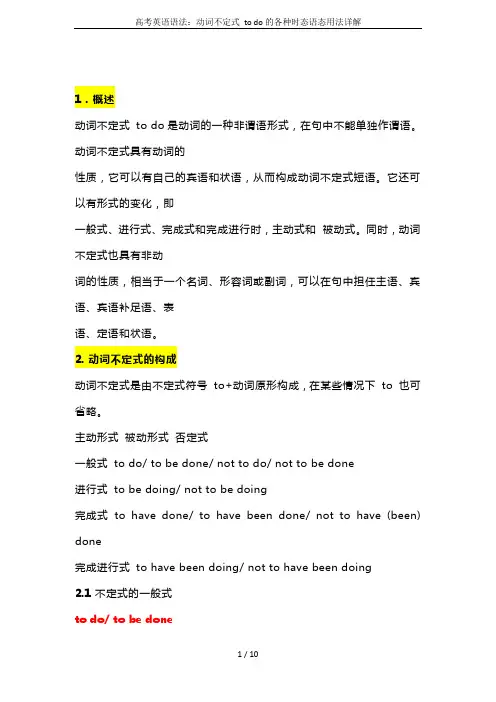
1.概述动词不定式to do是动词的一种非谓语形式,在句中不能单独作谓语。
动词不定式具有动词的性质,它可以有自己的宾语和状语,从而构成动词不定式短语。
它还可以有形式的变化,即一般式、进行式、完成式和完成进行时,主动式和被动式。
同时,动词不定式也具有非动词的性质,相当于一个名词、形容词或副词,可以在句中担任主语、宾语、宾语补足语、表语、定语和状语。
2. 动词不定式的构成动词不定式是由不定式符号to+动词原形构成,在某些情况下to 也可省略。
主动形式被动形式否定式一般式to do/ to be done/ not to do/ not to be done进行式to be doing/ not to be doing完成式to have done/ to have been done/ not to have (been) done完成进行式to have been doing/ not to have been doing2.1不定式的一般式to do/ to be donenot to do/ not to be done不定式的一般式表示的动作通常与主要谓语的动作同时或几乎同时发生,或是在它之后发生。
He appears to be very happy. 他看起来好像很高兴。
(同时发生)To catch the train, we'd better hurry to the station by taxi.为了赶上火车,我们最好赶紧乘出租车去车站。
(赶火车发生在到站之后)2.2不定式的进行式to be doing/ not to be doing不定式的进行式表示正在进行的或与谓语动词同时发生的动作。
It happened to be raining when I got there. 我到达那里的时候,天碰巧在下雨。
I'm glad to be traveling with you. 我很高兴和你一起旅游。

英语语法第75讲:不定式的时态和语态
在英语中,不定时是一个很重要的语法现象,前两天我们学习了不定时的特殊句型,今天我们再来学习一下不定时的时态和语态。
时态\语态主动被动
一般式 to do to be done
进行式 to be doing
完成式 to have done to have been done
完成进行式to have been doing
不定式常常用在现在时、完成时、进行时以及完成进行时中:
现在时:一般现在时表示的动词,有时与谓语动词表示的动作同时发生,有时发生在谓语动词的动作之后。
He seems to know this.
完成时:表示的动作发生在谓语动词表示的动作之前。
I'm sorry to have given you so much trouble.
He seems to have caught a cold.
进行时:表示动作正在进行,与谓语动词表示的动作同时发生。
He seems to be eating something.
完成进行时:
She is known to have been wreaking on the problem for many years.。
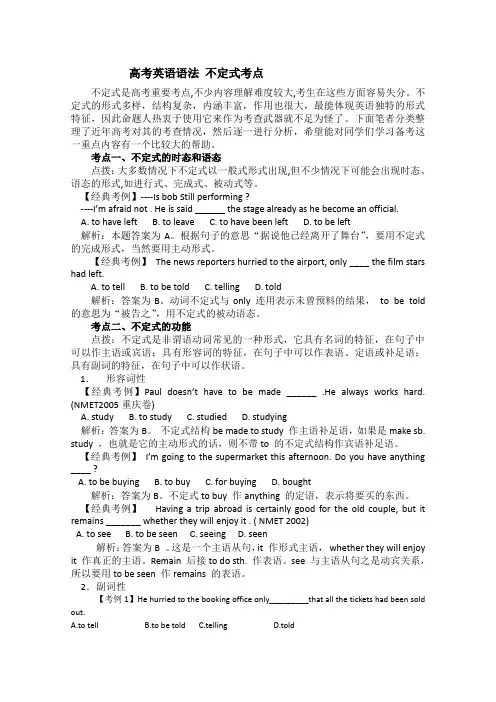
高考英语语法不定式考点不定式是高考重要考点,不少内容理解难度较大,考生在这些方面容易失分。
不定式的形式多样,结构复杂,内涵丰富,作用也很大,最能体现英语独特的形式特征,因此命题人热衷于使用它来作为考查武器就不足为怪了。
下面笔者分类整理了近年高考对其的考查情况,然后逐一进行分析,希望能对同学们学习备考这一重点内容有一个比较大的帮助。
考点一、不定式的时态和语态点拨:大多数情况下不定式以一般式形式出现,但不少情况下可能会出现时态、语态的形式,如进行式、完成式、被动式等。
【经典考例】----Is bob Still performing ?----I’m afraid not . He is said ______ the stage already as he become an official.A. to have leftB. to leaveC. to have been leftD. to be left解析:本题答案为A。
根据句子的意思“据说他已经离开了舞台”,要用不定式的完成形式,当然要用主动形式。
【经典考例】The news reporters hurried to the airport, only ____ the film stars had left.A. to tellB. to be toldC. tellingD. told解析:答案为B。
动词不定式与only 连用表示未曾预料的结果,to be told 的意思为“被告之”,用不定式的被动语态。
考点二、不定式的功能点拨:不定式是非谓语动词常见的一种形式,它具有名词的特征,在句子中可以作主语或宾语;具有形容词的特征,在句子中可以作表语、定语或补足语;具有副词的特征,在句子中可以作状语。
1.形容词性【经典考例】Paul doesn’t have to be made ______ .He always works hard. (NMET2005重庆卷)A. studyB. to studyC. studiedD. studying解析:答案为B。
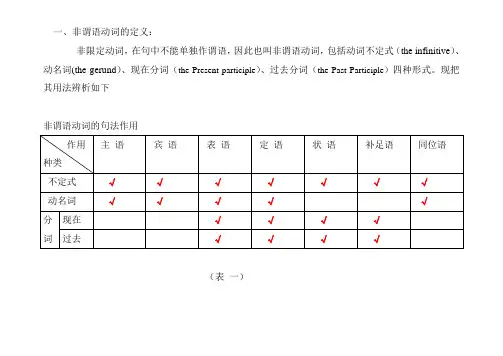
一、非谓语动词的定义:非限定动词,在句中不能单独作谓语,因此也叫非谓语动词,包括动词不定式(the infinitive)、动名词(the gerund)、现在分词(the Present participle)、过去分词(the Past Participle)四种形式。
现把其用法辨析如下非谓语动词的句法作用(表一)二.非谓语动词的时态和语态:1.不定式的时态和语态(表二)(表三)(表四)通过上述几个表格的比较,我们可以知道四种非谓语动词的时态和语态形式,下面我们再总结一下:1.非谓语动词的否定式:一律直接在非谓语动词之前加not 即可。
例如:(1)The doctor advised me not to smoke.(2)I regret not having gone together with her.(3)Not having been there before, I don’t know the shortest way to the railway station.(4)Not educated well, he found it difficult to solve such a complicate problem.2.非谓语动词的完成式:不定式的否定式我们只要在原来不定式中的动词之前加have即可,然后把原来的动词变为它的过去分词即可,如to do→not have done. 而过去分词只有一种形式,即done.下面我们重点来看现在分词和动名词的完成形式。
现在分词和动名词完成形式是完全一样的,其变化规律是:一律在现在分词或动名词的一般式之前加having→having done,再把原来的现在分词或动名词变为它的过去分词。
如stud y →having studied3.非谓语动词的被动式:不定式的被动:看表二现在分词和过去分词的被动:看表三动名词的被动:看表四从第二点我们可以知道现在分词和过去分词都可以表被动,那么他们有什么区别?区别:现在分词的被动形式除了可以表示被动之外,还可以表示进行过去分词除了表示被动之外还可以表示完成例如:(1)The house being built now will be a hospital.(2) The house built last year is a hospital.下面我们重点讨论一下现在分词和过去分词在句子中的用法。
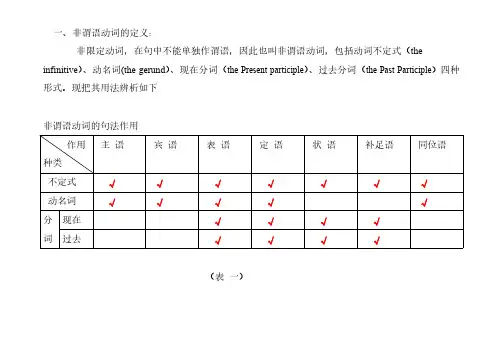
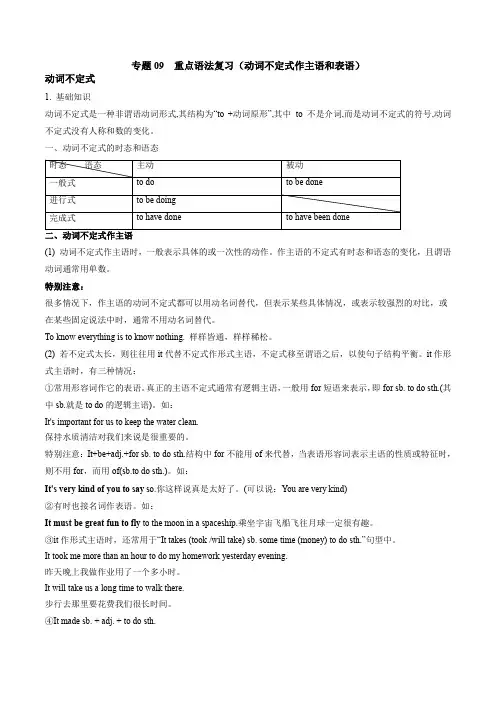
专题09 重点语法复习(动词不定式作主语和表语)动词不定式1. 基础知识动词不定式是一种非谓语动词形式,其结构为“to +动词原形”,其中to 不是介词,而是动词不定式的符号,动词不定式没有人称和数的变化。
一、动词不定式的时态和语态(1) 动词不定式作主语时,一般表示具体的或一次性的动作。
作主语的不定式有时态和语态的变化,且谓语动词通常用单数。
特别注意:很多情况下,作主语的动词不定式都可以用动名词替代,但表示某些具体情况,或表示较强烈的对比,或在某些固定说法中时,通常不用动名词替代。
To know everything is to know nothing. 样样皆通,样样稀松。
(2) 若不定式太长,则往往用it代替不定式作形式主语,不定式移至谓语之后,以使句子结构平衡。
it作形式主语时,有三种情况:①常用形容词作它的表语。
真正的主语不定式通常有逻辑主语,一般用for短语来表示,即for sb. to do sth.(其中sb.就是to do的逻辑主语)。
如:It's important for us to keep the water clean.保持水质清洁对我们来说是很重要的。
特别注意:It+be+adj.+for sb. to do sth.结构中for不能用of来代替,当表语形容词表示主语的性质或特征时,则不用for,而用of(sb.to do sth.)。
如:It's very kind of you to say so.你这样说真是太好了。
(可以说:You are very kind)②有时也接名词作表语。
如:It must be great fun to fly to the moon in a spaceship.乘坐宇宙飞船飞往月球一定很有趣。
③it作形式主语时,还常用于“It takes (took /will take) sb. some time (money) to do sth.”句型中。
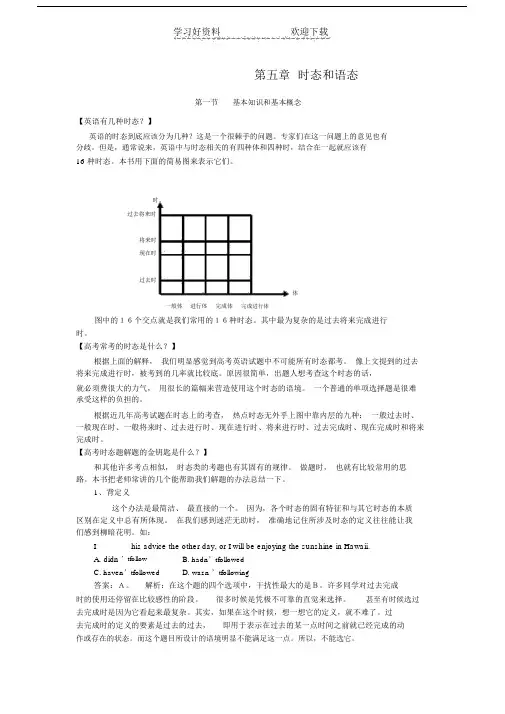
学习好资料欢迎下载第五章时态和语态第一节基本知识和基本概念【英语有几种时态?】英语的时态到底应该分为几种?这是一个很棘手的问题。
专家们在这一问题上的意见也有分歧。
但是,通常说来,英语中与时态相关的有四种体和四种时,结合在一起就应该有16种时态。
本书用下面的简易图来表示它们。
时过去将来时将来时现在时过去时体一般体进行体完成体完成进行体图中的16个交点就是我们常用的16种时态。
其中最为复杂的是过去将来完成进行时。
【高考常考的时态是什么?】根据上面的解释,我们明显感觉到高考英语试题中不可能所有时态都考。
像上文提到的过去将来完成进行时,被考到的几率就比较底。
原因很简单,出题人想考查这个时态的话,就必须费很大的力气,用很长的篇幅来营造使用这个时态的语境。
一个普通的单项选择题是很难承受这样的负担的。
根据近几年高考试题在时态上的考查,热点时态无外乎上图中靠内层的九种:一般过去时、一般现在时、一般将来时、过去进行时、现在进行时、将来进行时、过去完成时、现在完成时和将来完成时。
【高考时态题解题的金钥匙是什么?】和其他许多考点相似,时态类的考题也有其固有的规律。
做题时,也就有比较常用的思路。
本书把老师常讲的几个能帮助我们解题的办法总结一下。
1、背定义这个办法是最简洁、最直接的一个。
因为,各个时态的固有特征和与其它时态的本质区别在定义中总有所体现。
在我们感到迷茫无助时,准确地记住所涉及时态的定义往往能让我们感到柳暗花明。
如:I _______ his advice the other day, or I will be enjoying the sunshine in Hawaii.A. didn ’tfollowB. hadn’tfollowedC. haven’tfollowedD. wasn ’tfollowing答案:A。
解析:在这个题的四个选项中,干扰性最大的是B。
许多同学对过去完成时的使用还停留在比较感性的阶段。
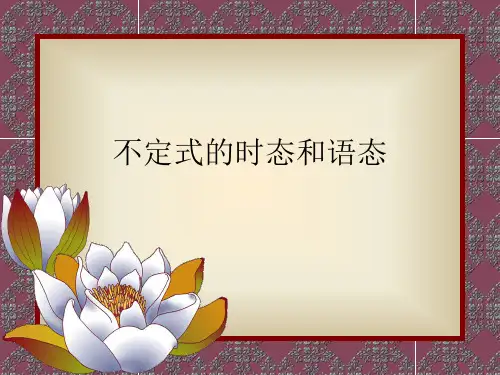
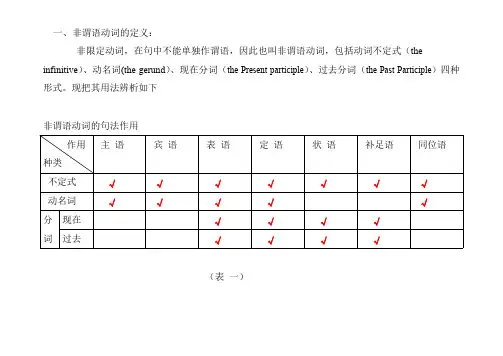
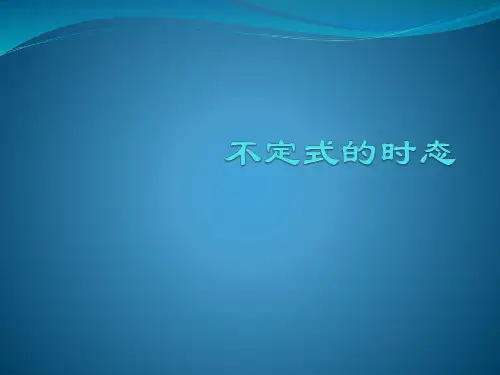
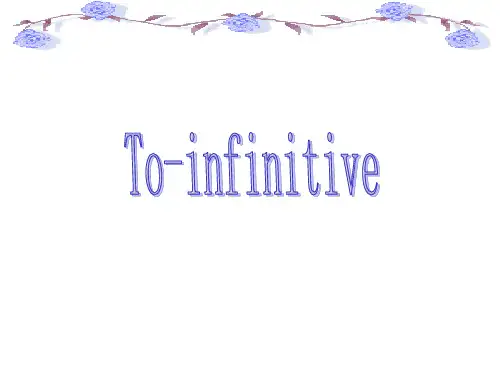
不定式的时态和语态总结归纳不定式的时态和语态:时态\语态主动被动一般式 to do to be done进行式 to be doing完成式 to have done to have been done完成进行式 to have been doing不定式的用法:1 现在时:一般现在时表示的动词,有时与谓语动词表示的动作同时发生,有时发生在谓语动词的动作之后。
He seems to know this.I hope to see you again. = I hope that I'll see you again. 我希望再见到你。
2 完成时:表示的动作发生在谓语动词表示的动作之前。
I'm sorry to have given you so much trouble.He seems to have caught a cold.3 进行时:表示动作正在进行,与谓语动词表示的动作同时发生。
He seems to be eating something.4 完成进行时:She is known to have been wreaking on the problem for many years.单项选择:1. The teacher told them ________ make so much noise.A. don’tB. notC. will notD. not to2. My mother often tells me _______so many mistakes.A. not to makeB. to not makeC. don’t makeD. not make3. Tell him _______ the window.A. to shut 关notB. not to shutC. to not shutD. not shut4. The boy wanted to ride his bicycle in the street, but hismother told him ______. A. not to B. not to do C. not do it D. do not to5. Mrs Smith warned警告 her daughter ________ after drinking.A. never to driveB. to never driveC. never drivingD. never drive6. The doctor asked the patient ____rich food after the operation手术.A. to eat notB. eating notC. not to eatD. not eating7. The workers want us ________ together with them.A. workB. workingC. to workD. worked8. I saw him _______ out of the room.A. goB. wentC.is goingD. goes9. He often makes his little sister _____,A. cryB. cryingC. criedD. to cry10 There’re so many kinds of new bikes on sale that I can’t make up my mind _____ to buy.A. whatB. whichC. howD. where11. He can’t decide ______ to stay or not.A. whetherB. ifC. eitherD. if he will12. --- The light in the office is still on. --- Oh, I forgot _______.A. turning it offB. turn it offC. to turn it offD. turned it off13. We agreed _________ here.A. metB. meetingC. to meetD. meet14. Frank is the kind of person who people like to ________.A. make friend withB. make friends ofC. make friendsD. make friends with 15. Go on ________ the other exercise after you finishthis one.A. to doB. doingC.doesD. did16. She reached the top of the hill and stopped _______ on a big rockA. restedB. restingC. to restD. rest17. Tom kept quiet about the accident because he was afraid of____ his job.A. loseB. to loseC. losingD. lost18. I need a day or two ________.A. to think it overB. to think overC. of thinking19. He was too excited _________.A. speakB. to speakC. not to speakD. speaking20. I’m hungry. Get me something _________.A. eatB. to eatC. eatingD. for eating21. --- I usually go there by train.--- Why not _______ by boat for a change ?A. to try goingB. trying to goC. to try and goD. try going22. I asked him to _______ me a few minutes so that we could go over all the problems.A. spendB. spareC. saveD. share23. They won’t let his mother _______him in that way.A. to treatB. treatedC. treatD. treats24. I’m sorry I forgot ______your dictionary. Let’s borrow one from Li Ming. A. to take B. taking C. to bring D. bringing25. She couldn’t decide which restaurant _______.A. to have lunchB. to eatC. to eat atD. eating at26. Don’t forget _________ the letter .A. to sendB. sendC. sendingD. sent27. The chair looks very old, I want a new one _________ .A. sitB.to sit onC. satD.sit on28. Is ______ necessary to return the book tomorrow ?A. thisB. thatC. itD. which29. I’m afraid they would not allow允许 him ________ here .A. to ... okeB. ... okingC. ... okesD. ... oke30. Mother told me ________ the water before I drank it .A. boilingB. boiledC. boilD. to boil31. On my way home , I stopped _______ some food .A. buyB. to buyC. buyingD. bought。